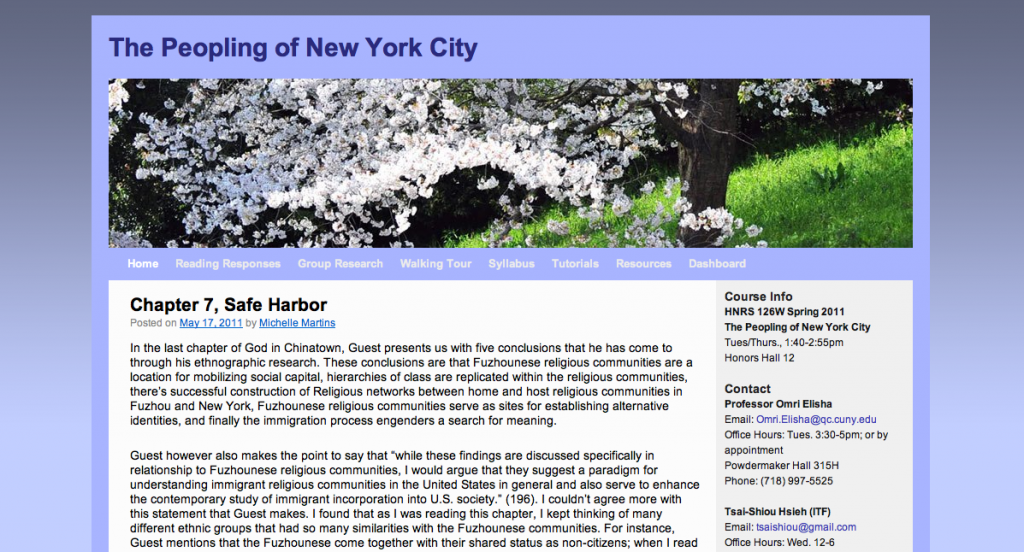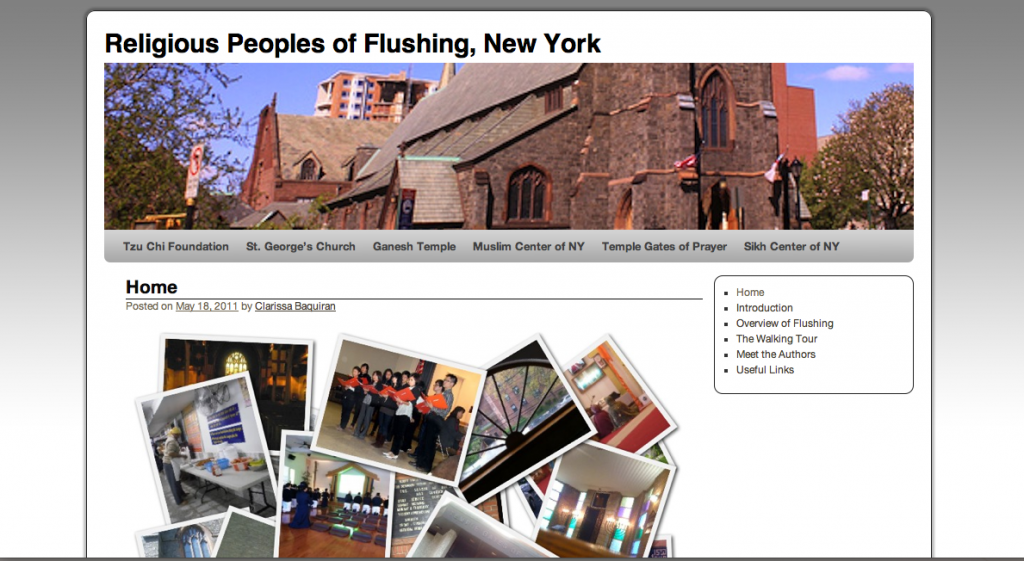Below you’ll find two sites which were used for the same class, a Macaulay Honors College Class called ‘The Peopling of New York City’. Both sites use a platform very similar to what you’ll be using in the fall. I like these largely because they’re relatively simple–while often we benefit from students who can do amazing things with our sites, this is a relatively standard set up that (I promise) any of you will be able to do by the end of the Fall 2011 term. One thing I do want to remind you of (and I’m sure I’ll be saying this again), don’t be intimidated by sites like this–we’re looking at what took an entire term to build, and each of these started as bare bones sites, with just a syllabus and a not much more.
To the sites then. The first is the class’ main site, which I imagine most of you will imitate to some degree. Here we have a syllabus, resources, a page where students post short writing responses, and guidelines on larger projects (the equivalent of a handout). Much of what’s here is going from professor to student, except the student responses. Click the image to be taken to site itself, and have a look around.
Below, then, you’ll see the second class site, which is the student-directed research project. This is nicely done, and most pages are within most student capabilities (maybe with a little help from your community facilitator)*. It’s a nice project, with video, a pleasant look, and a rigor that I think the students can be proud of. You can click this image to have a look as well.
*if you’re curious, this page is one students will be able to do with just a little training. This one is a bit trickier.





Great examples, Scott! I find these to be extremely helpful in visualizing what we might do with our course sites. I am inspired!
Scott,
I echo Shelley’s comments. Our faculty and students have an appetite that will be insatiable once a couple of these examples go live. What better way to make teaching related activities visible, generate conversation, share information and test concepts.
Looks like the students had a good time with these websites. Oh, for those days to read, discuss, and explore. I’ll sign up for the course.
Now for the teaching that goes into these two deliverables. As we muddle through gen-edding our work for the fall, we could benefit to see these websites in context. The gestalt. So as usual, I have a bunch of questions.
The syllabus on the first site is actually an in-class presentation schedule. Did I miss something? A syllabus would help us (me) understand the design of this course. Such things as:
• Why did these students choose their culminating event? How did they do it? Research? Interviews? Observation?
• What were the measurable Learning Outcomes?
• What assessments and rubrics were used?
• Did these students do other individual writing besides the book commentaries and the committee aggregated content for the website?
• What was used for the web-base course management? How?
Other questions: Were these websites only germane to the class? How did they help the students relate to/interact with each other? The college? The city? The world wide web? The kind of stuff Jim Grooms demonstrated so passionately?
[And personally] How do we go from the lively freedom of a humanities environment that these websites demonstrate to our first-year skill-based courses, with their rigorous competencies and their clearly defined outcomes? For example, the CATW, the COMPASS Reading Test, English 1101, Math, Biology. . .
Took a short break, but now I’m back ready to take up my end of the conversation.
Hope your summer is sweet.
Wonderful thoughts Charles. I’ll see if I can find out the answers to some of your more practical questions about how the class was managed. In the meantime, there is a syllabus on the site that might give you a bit more information (the dropdown menu is a bit misleading). You can find that here: http://macaulay.cuny.edu/eportfolios/oelisha11/syllabus/
I’m particularly drawn to that last question–it’s one I puzzle over myself. These sorts of course sites encourage students to explore their interests, certainly, and that can seem to lead away from those ‘rigorously defined competencies’ you’re talking about. I have a unwavering faith that they aren’t exclusive, but appreciate the concern over measurability, and would love to hear anyone’s thoughts on the topic.
That said, the sort of ‘free-play’ model of course site that you see here (particularly in that research project site), is really a matter of content, not form. There’s no reason that an online platform wouldn’t work for any course we teach. I’ll be posting some examples that might reflect the needs of first-year skills-based courses as we go.
And happy summer to you, too.